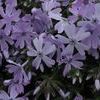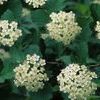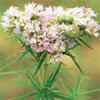Native Plants

|
Common Name: Golden Ragwort
In early spring, above 12" - 24" sparsely leaved stems, yellow daisy-like flowers open. This semi-evergreen is a good choice for moist, shady locations however it spreads rapidly and may be aggressive....
[ More Info ] [ Add to Shopping List ]
|

|
Common Name: Squaw-weed
From early April through June, loose umbels of yellow flowers on appear on 12" stems. The foliage forms rosettes and is semi-evergreen, with rounded and serrated leaves. It grows well in dry shade and spreads by underground stems. This native plant i...
[ More Info ] [ Add to Shopping List ]
|

|
Common Name: Switch Grass
This is a warm season, mid-height grass that is clump-forming. In mid-summer, the foliage is topped with finely-textured, pink-tinged, branched flower heads that rise three feet above the foliage turning beige in the fall with the seed plumes persis...
[ More Info ] [ Add to Shopping List ]
|

|
Common Name: Virginia Whitlow Wort
Small striking plant with yellow late spring blooms. Occurs on outcrops....
[ More Info ] [ Add to Shopping List ]
|

|
Common Name: Wild Quinine
From late spring to late summer, wooly-looking, white flowers bloom in broad, flat-topped heads. The long-petioled basal leaves are larger than the stem leaves and grow in a distinct clump. The leaves are aromatic....
[ More Info ] [ Add to Shopping List ]
|

|
Common Name: Virginia Creeper
In spring, leaves composed of five leaflets emerge that are bronze to dull green in summer then turn purple to crimson-red in fall. In late spring to early summer, clusters of small, greenish-white flowers appear on this deciduous, climbing woody vi...
[ More Info ] [ Add to Shopping List ]
|

|
Common Name: Passion Flower
This vine, which climbs by tendrils, is native to southern Missouri. From mid-summer to early fall, it produces intricately fringed flowers up to three inches across that are purplish blue with pink and white parts. The edible fruit, up to two inch...
[ More Info ] [ Add to Shopping List ]
|

|
Common Name: Arrow Arum
This easy to grow, spectacular tropical-looking native plant grows well in sun or partial shade. It is great for small ponds or containers. In late spring, greenish-white spathe and spadix flowers appear followed by green seedpods that ripen to shi...
[ More Info ] [ Add to Shopping List ]
|

|
Common Name: Purple Beard Tongue
In June, show-stopping spikes appear of loosely spaced white to violet to deep purple two inch long tubular flowers bloom on erect stems. They are larger than other penstemon. Often seen blooming in late spring on rocky outcrops and road cuts, this...
[ More Info ] [ Add to Shopping List ]
|

|
Common Name: Foxglove Beard Tongue
In May and June, tubular white flowers carried on strong stems provide nectar for hummingbirds. In the fall, the foliage turns reddish. Attractive seed heads are also produced on this handsome addition to the garden. This white flowering native is ...
[ More Info ] [ Add to Shopping List ]
|

|
Common Name: Large-flowered Beardtongue
Lavender-blue bells hang like foxgloves on tall stems. This penstemon is truly statuesque with its tough blue-green foliage and hearty stalks of long, tubular flowers. Hummingbirds are attracted to the rich nectar; bumblebees totally disappear into ...
[ More Info ] [ Add to Shopping List ]
|

|
Common Name: Hairy Beardtongue
Native wildflower to the eastern United States which occurs on rock outcrops. Thrives on thin soil, good drainage, and open shade or full sun. Lavender to white flowers are borne on tall, erect stems in early to mid-summer. It is the shortest of our ...
[ More Info ] [ Add to Shopping List ]
|

|
Common Name: Small's Beardtongue
White throated rosy lavender trumpets peek out from the base to the top of the rich green foliage. Does well in heat, and is a friend to butterflies and hummingbirds. The pink to deep rose tubular flowers with purple-striped white throats bloom from ...
[ More Info ] [ Add to Shopping List ]
|

|
Common Name: Prairie Beard Tongue
Blooms from mid-spring to mid-summer with spires of tubular white flowers arranged in 'ring' or tight clusters around strong, slender stems with the main leaves appearing well below the flowers. Flower clusters, similar to Foxglove Beard Tongue, are...
[ More Info ] [ Add to Shopping List ]
|

|
Common Name: Ditch Stonecrop
This colonizing, wet-loving native occurs in ditches and on streambanks. Small, green flowers bloom from July to October. An excellent choice for wetland mitigations and bioswales....
[ More Info ] [ Add to Shopping List ]
|

|
Common Name: Sand Phlox
In spring, this low-spreading native grows in dry areas with sun or shade adorned with beautiful, pale-purple, star-like flowers. The flowers have a V-shaped notch on each petal giving them a fringed look. The leaves, which are short, thread-like ...
[ More Info ] [ Add to Shopping List ]
|

|
Common Name: Wild Sweet William
Sweetly scented, star-shaped blue to blue-violet flowers in loose clusters emerge in spring and provide nectar for butterflies and hummingbirds....
[ More Info ] [ Add to Shopping List ]
|

|
Common Name: Annual Phlox
Easy-to-grow annual with showy, five-lobed tubular flowers. Flowers can be white, red, magenta, lavender, or pink and usually have a lighter-colored "eye" in the center....
[ More Info ] [ Add to Shopping List ]
|

|
Common Name: Meadow Phlox
This Meadow Phlox blooms earlier than Tall Phlox (Phlox paniculata) with mauve-pink flower heads on top of stems with thick, glossy leaves. The flowers are fragrant and attract butterflies and hummingbirds. The stems sometimes have a red mottling a...
[ More Info ] [ Add to Shopping List ]
|

|
Common Name: Garden Phlox
The large, fragrant magenta flower clusters can grow eight inches across. These showy blossoms attract butterflies and hummingbirds. They make good cut flowers. They are most showy in the landscape when grown in moist soil....
[ More Info ] [ Add to Shopping List ]
|

|
Common Name: Downy Phlox
In late spring, loose clusters of fragrant, long-blooming, pink to purple flowers appear. The nectar is a good source of food for butterflies. The plant spreads slowly by underground stems and forms large colonies. It is a species that has excelle...
[ More Info ] [ Add to Shopping List ]
|

|
Common Name: Creeping Phlox
Clusters of five-petaled flowers in vibrant shades of pink, red, lavender, blue-purple, or white cover this spring-flowering, short accent groundcover. Commonly used in rock gardens, along paths, at foundations and at the edge of beds or cascading ov...
[ More Info ] [ Add to Shopping List ]
|

|
Common Name: Ninebark
This handsome shrub is a Plants of Merit winner. In May and June, Ninebark blooms for an extended period with clusters of white to pinkish flowers resembling Bridalwreath Spirea. In fall, seed is formed in reddish drooping clusters which are enjoyed...
[ More Info ] [ Add to Shopping List ]
|

|
Common Name: Narrowleaf Obedient Plant
A long lived native wildflower that blooms from June to September. Pale purple or rose flowerheads will stay turned if manipulated. Occurs along riverbanks and moist shorelines....
[ More Info ] [ Add to Shopping List ]
|

|
Common Name: Obedient Plant
This native wildflower is easily grown in average to moist well-drained soil in full sun. Plants form erect clumps and naturalizes in gardens. Stiff, square stems feature dense spikes of pinkish, snapdragon-like flowers which bloom throughout the su...
[ More Info ] [ Add to Shopping List ]
|

|
Common Name: Norway Spruce
Large evergreen coniferous tree which occurs throughout northeast Europe, Prized for blue-green needle color and excellent landscape form....
[ More Info ] [ Add to Shopping List ]
|

|
Common Name: Shortleaf Pine
Shortleaf Pine occurs in dry, sandy or rocky upland areas in the Ozark region. This is a medium-sized, fast-growing pine with a short pyramidal crown which broadens somewhat with age. Typically grows 50-60' tall in cultivation, but will grow to 100' ...
[ More Info ] [ Add to Shopping List ]
|

|
Common Name: White Pine
Large evergreen tree that may serve as a specimen, group planting, windbreak, or visual screen. Characteristic soft, bluish-green to medium-green needles occur in bundles of five....
[ More Info ] [ Add to Shopping List ]
|

|
Common Name: Loblolly Pine
Rapid growing evergreen with loose pyramidal shape in youth, horizontal branches and rounded crown...
[ More Info ] [ Add to Shopping List ]
|

|
Common Name: Sycamore
This large tree develops a massive trunk with an open wide-spreading crown and has leaves that can grow to nine inches in width. In winter, the tree's characteristic large patches of creamy white inner bark are prominent making it a winter landscape...
[ More Info ] [ Add to Shopping List ]
|

|
Common Name: Mayapple
This beautiful plant is like an umbrella in the shade garden. Large notched pairs of leaves up to one foot in width are held on 12" - 18" stalks. In the spring, simple creamy white single flowers dangles under the leaves. In May, "apples" form, wh...
[ More Info ] [ Add to Shopping List ]
|

|
Common Name: Jacob's Ladder
Althrough the growing season, the foliage looks fresh and green. In mid to late spring, pretty light-blue, bell-shaped flowers appear in loose clusters on sprawling, weak stems....
[ More Info ] [ Add to Shopping List ]
|

|
Common Name: Solomon's Seal
In May, small, greenish-white flowers hang from arching stems giving way to blue berries in summer. In the fall, the foliage turns golden. Solomon's Seal forms handsome stands in shady environments, spreading slowly by creeping rhizomes....
[ More Info ] [ Add to Shopping List ]
|

|
Common Name: Christmas Fern
A native fern with beautiful glossy, deep-green, lance-shaped fronds. The fronds emerge upright and arch gently. They eventually lay down to cover the ground as they mature. It is one of the first ferns to emerge in spring and has hairy brown leaf...
[ More Info ] [ Add to Shopping List ]
|

|
Common Name: Nuttall's Prairie Parsley
Erect, stout stems are one to three feet in height. Alternate leaves are pinnately compound on stalks one to six inches long. Loose, somewhat rounded compound umbel-shaped flowers are up to three inches across, with six to 12 rays that are about two...
[ More Info ] [ Add to Shopping List ]
|

|
Common Name: Pickerel Plant
The blue-violet flower spikes of this hardy water plant stand out at the edge of a pond or in a small pool from June through October. Large stands make a very showy statement. Glossy green, lance-shaped leaves grow vertically out of the water....
[ More Info ] [ Add to Shopping List ]
|

|
Common Name: Eastern Cottonwood
Deciduous trees with smooth grey or white bark, sometimes rough on the lower trunk. Leaves are usually roughly triangular or diamond-shaped, on a long stalk, with a paler green or white underside. Tiny flowers in long drooping catkins are produced in...
[ More Info ] [ Add to Shopping List ]
|

|
Common Name: Wild Plum
Grown as a single trunk tree or a multi-stemmed shrub, this native tree is among the first to bloom in spring with pure white, fragrant flowers. The edible, one-inch diameter yellow-to-red fruits are favored by birds. They also are used to make flavo...
[ More Info ] [ Add to Shopping List ]
|

|
Common Name: Black Cherry
In May, beautiful long tassels of white flowers droop from the branches. In September, red fruits ripen to black. The dark green leaves turn yellow to red in fall. The fruit is edible but can be messy and seedlings can be a problem if not tended. ...
[ More Info ] [ Add to Shopping List ]
|

|
Common Name: Choke Cherry
This small suckering tree or large shrub forms large upright clumps. Spring blossoms are attractive white flowers in dense, cylindrical clusters three to six inches long. It has an unusual tolerance for shade and can be grown in an understory or scr...
[ More Info ] [ Add to Shopping List ]
|

|
Common Name: Hop Tree
A large shrub or small tree with a bushy rounded form. Fragrant, greenish flowers bloom from April to June and provide nectar for bees. Flowers are followed by yellow-green, winged fruits that later turn brown and persist through winter. The Hop Tree...
[ More Info ] [ Add to Shopping List ]
|

|
Common Name: Slender Mountain Mint
In mid to late summer, this plant is covered by a profusion of small white flowers, which are an excellent nectar source for butterflies. The needlelike foliage is very aromatic. It grows as a compact clump and may be used to make tea....
[ More Info ] [ Add to Shopping List ]
|

|
Common Name: Virginia Mountain Mint
From July to September, white flowers bloom that are spotted with pink or violet. Petals are fused into a tube for their lower half, but free in their upper halves. Top two petals fused into a single lobe, other petal lobes splayed with a ragged appe...
[ More Info ] [ Add to Shopping List ]
|
